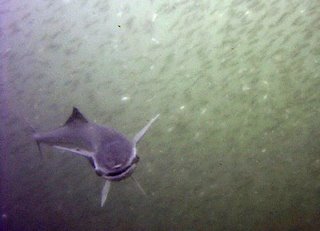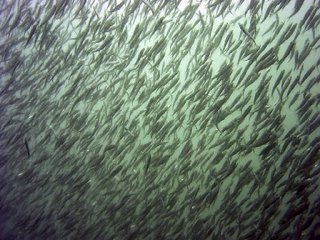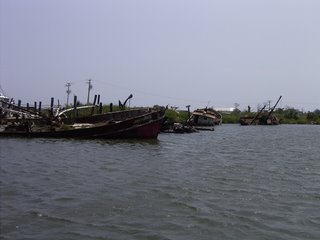"THE INDIGO LEDGES are 70 to 80ft deep and is a great site for Open Water divers. This natural reef line supports a variety of soft corals, sponges and crustaceans. Tropical fish such as the angel are frequent visitors and large pelagics may be seen in the area. The Ledges provide the unique opportunity to drift dive in this area when conditions allow."
Think of the ledge as a place where its 70 feet on the high side, and 80 feet on the deep side. In between there is what looks just like a coral reef you would expect to find in the carribbean. Nooks and crannies, lots of fish to see, corals, shells, etc... The Indigo ledges got their name because it was found by Charleston Scuba 's owner after salvaging a boat called "Indigo". They passed over the ledge either on the way in or out, and must have taken note of the numbers for a later look. I'm glad they did, because this is a nice dive site.
I was really hoping to see a sand tiger shark, but wasn't that lucky. I brought my camera and took a few pics of the sealife. I was diving solo and was the first diver down the line. I looked back to find four divers behind me, all wanting someone else to be the first on the site just in case there was a shark. Viz was carribbean-like, at 60'+, and it was warm....really warm. First in and last out...just the way I like it.
The second dive was supposed to be an artifical reef which had a bunch of piles of rubble, including some old military vehicles and a few larger ships. There were six sport fishing boats on them and they didn't seem too happy to see a dive boat approach. After 30 minutes of trying to find a decent place to hook in, we gave up and went to the wreck of the Frederick W. Day.
"THE FREDERICK W. DAY was a wooden schooner built in 1901 and sank off the coast of Charleston, South Carolina on September 17, 1914, loaded with bags of cement. The bags have formed a reef approximately 200ft long with the top of the reef at 40ft and the bottom at 54ft. There is an abundance of fish and other marine life around the wreck, creating one of the nicest dives off Charleston."
Since I was solo, I buddied up with a diver whose buddy was a little "green" and didn't dive. We were the first in and I immediately noticed a large remora swimming around beneath the boat. He was about 2 1/2 feet long, which I believe is on the large side.
 As I decended the line, this damn remora was all over me. I think he was trying to latch onto my mask and it was freaking me out. I know they are harmless, but this guy was a pain in my ass.
As I decended the line, this damn remora was all over me. I think he was trying to latch onto my mask and it was freaking me out. I know they are harmless, but this guy was a pain in my ass.I got onto the wreck to find most of the actual ship gone. Remaining is a huge heap consisting of of cement, each piece the size and shape of the bag which once contained it. The cement forms the shape of the hull. There was a large anchor on the sand just in front of the bow. Someone obviously tried to raise it, as indicated by the canvas line wrapped around it. Luckily, this attempt was unsuccessful, allowing the anchor to be seen by divers for years to come instead of being in someone's shop or backyard. After 35 minutes, my dive buddy indicated he needed to ascend due to his air supply, so I escorted him to the anchor line and up he went...by himself. I stayed down and tagged along with the Captain and one of his mates. We just kept cruising around the wreck looking for turtles, sharks, or rays. Unfortunately, we saw none. There were thousands of little bait fish swimming all around me, sometimes enveloping me to where I saw almost no light.
 They swam in unison all around, above and below me. I know that the big fish feed on these litle guys and I was hoping to see some of the big guys dining on these little guys, but no such luck. After an hour dive time, I saw them begin their ascent, so I decided to join them. Ahhh....again the first in and last out.
They swam in unison all around, above and below me. I know that the big fish feed on these litle guys and I was hoping to see some of the big guys dining on these little guys, but no such luck. After an hour dive time, I saw them begin their ascent, so I decided to join them. Ahhh....again the first in and last out. Here is a link to about a dozen pictures from this trip, which includes the post directly below as well....WreckValley Photo Gallery


